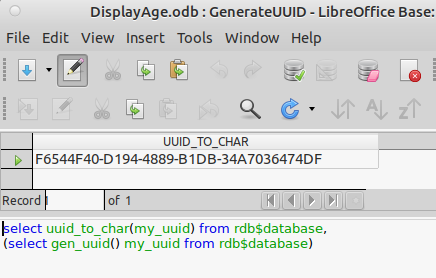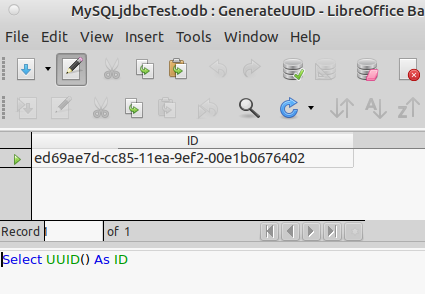When transferring records between BD users, what do you use to prevent confusion between records with the same ID?
Just for my curiosity: What is a “BD user”?
There must either be an authority managing such identifiers (which we only have for special purposes), or an identifier (add-to most likely) must be generated randomly targeting into a sufficiently large space with a reliable algorithm to get uique values with sufficiently high probability without additional measures.
A standard seems to be to use 128-bit values, which can distinguish more tha 10^38 values.
(About 2 000 000 000 000 000 000 000 000 000 000 per currently living human).
Where restricions are neecessary, they must be negotiated.
Just one finding on the subject e.g.: Generating UUIDs at scale on the Web | by Matthieu Wipliez | Teads Engineering | Medium
I’ve skimmed the article; interesting. However, specifically how are people getting a UUID or GUID into an LO Base field?
I’m coming from a Filemaker background where you’d auto-enter UUID into 1 field of each record of each table. It needs to have a similar mechanism to be practicable.
Hello,
This is not available in Base but many newer databases (HSQLDB v1.8 embedded is not one) provide a function:
HSQLDB (v2.x & up)

Firebird -

MySQL -

and PostgreSQL documentation:
PostgreSQL provides storage and
comparison functions for UUIDs, but
the core database does not include any
function for generating UUIDs, because
no single algorithm is well suited for
every application. The uuid-ossp
module provides functions that
implement several standard algorithms.
The pgcrypto module also provides a
generation function for random UUIDs.
Alternatively, UUIDs could be
generated by client applications or
other libraries invoked through a
server-side function.
This is limit of checking done. It is likely other DB’s as similar.
Another option to create a universally unique identifier (UUID) is this formula
=CONCATENATE(
DEC2HEX(RANDBETWEEN(0;4294967296);8);"-";
DEC2HEX(RANDBETWEEN(0;65536);4);"-";
DEC2HEX(RANDBETWEEN(0;65536);4);"-4";
DEC2HEX(RANDBETWEEN(0;4096);3);"-";
DEC2HEX(RANDBETWEEN(0;4294967296);8);
DEC2HEX(RANDBETWEEN(0;65536);4))
Example of random end result 8D8AC610-566D-4EF0-9C22-186B2A5ED793
Below is the answer as above. But with details for those interested.
Assumptions about the formula above:
-
It requires only LibreOffice Calc. No need to connect to a database to create a UUID. Optionally, after a UUID is created in Calc, you are able to use it to do operations with any connected database to your liking.
-
Your Calc is configured to use English local
-
Within the UUID third group, the
4prefix communicates that this UUID is based on UUID version 4. This number if fixed. All the other value may change. Details at
If your Calc is in another local (language), you need to adapt this formula appropriately.
For example, in French the correct formula is this:
=CONCATENER(
DECHEX(ALEA.ENTRE.BORNES(0;4294967296);8);"-";
DECHEX(ALEA.ENTRE.BORNES(0;65536);4);"-";
DECHEX(ALEA.ENTRE.BORNES(0;65536);4);"-4";
DECHEX(ALEA.ENTRE.BORNES(0;4096);3);"-";
DECHEX(ALEA.ENTRE.BORNES(0;4294967296);8);
DECHEX(ALEA.ENTRE.BORNES(0;65536);4))
For creating a new UUID, simply exit the cell edit mode, while you view the cell, press F7 key, this will automatically calculate a new UUID.
Attribution to Matt for the inspiration about this formula. Which I adapted for both UUID version 4 format and the maximum amount of Hex values. Which I assume is 16^8 = 4294967296, 16^4 = 65536, 16^3 = 4096.
Note that semicolon is accepted in all locales, even those that use other separators in the UI (so they will accept the formula with semicolons, and then show the separators as configured locally). Which is why it is advised to always use semicolons as separators when pasting formulas to sites, to minimize problems for users. If only there existed a similarly universally accepted format for other parts (like decimal separator or function names)…
Thanks for your reply @mikekaganski  I learned something new. I adapted my answer accordingly.
I learned something new. I adapted my answer accordingly.
This is good news that semicolons are universally accepted. I prefer formulas with semicolons. As they are easier to read.
